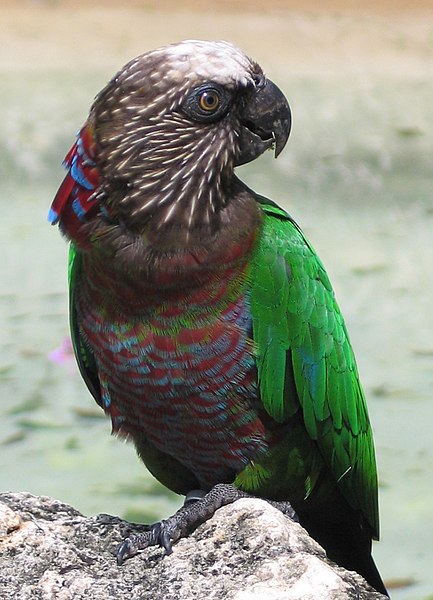Parrot owners often tend to focus on their birds’ speaking abilities, but it is the many vocalizations that our pets make naturally that represent their true efforts at communicating with us. Following are a few commonly-heard parrot sounds and their usual meanings.

Beak Grinding
People often grind their teeth at night, when under tension. Beak grinding has a similar sound, and so is often misinterpreted as indicating stress or aggression. However, in parrots, beak-grinding is usually a sign of contentment, given as darkness falls or sometimes while the bird is sleeping.
Beak Clicking
Beak clicking, the rapid snapping of the upper and lower mandibles, is a threat, most often issued when the parrot is protecting its territory, mate or favored person. Clicking is often accompanied by pupil dilation and a raising-up of the feathers, wings and/or foot (the hawk head parrot exhibits an extreme feather-raising display…please see photos).
Tongue Clicking
Unlike beak clicking, tongue clicks are uttered when a parrot is secure and seeking attention. Most often heard in cockatoos >(including cockatiels), the sound is much the same a person makes when clicking the tongue against the roof of the mouth.
Growling
Low, guttural growls indicate that a parrot is stressed and aggressive, and likely to bite if approached. Growling parrots often raise their neck and other feathers, fan their tails and appear taut and ready for action. The pupils will be dilated as well.
Purring
Purring is sometimes difficult to distinguish from growling; it is lower than growling, and sounds “less aggressive” somehow. Your parrot’s body language is an important key in determining the nature of the sound it is making…the pupils of a purring parrot will usually not be dilated, its feathers will be down and its stance may appear “relaxed”.
Further Reading
Please check out the book The Parrot Problem Solver for valuable information on parrot sounds and body language.
An interesting technical paper on parrot vocalization analysis is also an interesting insight.
Hawkheaded Parrot image referenced from wikipedia and originally posted by Snowmanradio
Hawkheaded Parrot scratching image referenced from wikipedia and originally posted by Goaly
 That Bird Blog – Bird Care and History for Pet Birds
That Bird Blog – Bird Care and History for Pet Birds

 The vibrant colors and unique erectile head crest of the hawk headed or red fan parrot (Deroptyus accipitrinus) have long rendered it a favorite pet in its native South America. After the first exports in the mid 1800’s, the bird achieved instant stardom in zoos and private collections worldwide.
The vibrant colors and unique erectile head crest of the hawk headed or red fan parrot (Deroptyus accipitrinus) have long rendered it a favorite pet in its native South America. After the first exports in the mid 1800’s, the bird achieved instant stardom in zoos and private collections worldwide.